How to Counteract Bitterness in Mustard Greens
Blanching is very helpful for reducing the bitter flavor that exists in mustard greens. So is simmering mustard greens for a long time after the blanching.
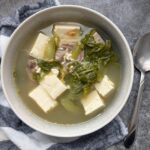
Cantonese tofu soup with mustard greens
Ingredients
- 2 lbs pork neck bones
- 3 quarts water
- 1/2 quart chicken broth
- 2 inch piece of ginger thinly sliced
- 1/2 package silken tofu
- 2 cups mustard greens thinly sliced
- 1 salted duck egg coarsely chopped
Instructions
- Bring a large pot of water to boil. Add in neck bones and allow to boil for 7 minutes until impurities start coming out.
- Then discard the water, clean the bones by rubbing off impurities. Then fill your pot with 4 quarts of water, 1/2 quart of chicken broth, sliced ginger, salted duck egg, and the cleaned pork bones. Bring to a boil on high heat, then allow to simmer on medium low heat for 2.5 hrs until pork meat has softened.
- Meanwhile, bring another large pot of water to boil. Blanch mustard greens for 5-7 minutes. Then remove mustard greens from the water and set aside. Discard the water.
- After 2.5 hours of pork bones simmering, add in 1 tbsp of fish sauce, 1 tsp salt, the blanched mustard greens, and silken tofu. Allow to simmer for another 10-15 minutes. Taste for seasoning and add salt to taste. Serve hot.
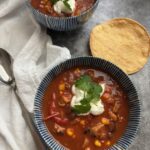
One-pot chicken tortilla soup
Ingredients
Soup
- 1 tsp salt
- 1.5 lbs skinless boneless chicken thighs
- 1 tbsp neutral oil
- 1/2 onion sliced
- 3 cloves garlic minced
- 1 jar red enchilada sauce
- 2 tsp taco seasoning
- 1 tbsp chicken bouillon
- 28 oz crushed tomatoes
- 1 quart water
- 1 jar roasted red peppers drained and sliced
- 2 bay leaves
- 1 tsp oregano
- 1 can black beans drained
- 1 bag frozen corn
Garnishes
- 6 corn tortillas
- 1/2 cup Sour cream optional
- 1 bunch Cilantro chopped optional
- 1 bunch Green onion chopped optional
Instructions
- Season chicken thighs with salt. Heat a stockpot on high heat. Put in oil. When oil is shimmery and pan is hot, sear chicken thighs until golden brown on each side. Then add in onions and garlic and saute for 2 minutes.
- Then add in enchilada sauce, taco seasoning, chicken bouillon, crushed tomatoes, water, roasted peppers, bay leaves, and oregano. Bring to a boil and simmer on medium for 45 minutes.
- While soup is simmering, preheat an oven to 350 degrees. Place 6 corn tortillas onto a single layer in a baking sheet. Bake for 20 minutes, then turn off oven and leave tortillas in the oven for another 5-7 minutes. Then remove from the oven. Tortillas should be crispy and golden brown. Set aside.
- After 45 minutes of the soup simmering, remove chicken from the soup and chop up into small cubes. Then add back into the soup. Add in black beans and frozen corn. Allow to simmer for another 5 minutes. Taste for seasoning and seasoned salt to taste.
- Optional: garnish with sour cream, green onion, and cilantro
- Serve hot with crispy tortillas and garnishes.
For other easy soup recipes, check out my creamy Tuscan sausage soup.
The post One-Pot Chicken Tortilla Soup appeared first on Jenn's Kitchen Diary.]]>Why parboiling bones is important
Bones have lots of blood and impurities in them. To make a nice and clear bone broth, boiling them at high heat and then rinsing out impurities is essential. That is a critical step for any clear broth, but especially this lotus root pork bone soup.
How to parboil bones for lotus root pork bone soup
Set a pot of water to boil. There should be enough water to submerge the bones completely.
Once the water is boiling, add in the bones (e.g., chicken, beef, pork). Allow blood and other impurities to boil out into the broth for at least 5 minutes.
Then remove the bones from the heat and pour out the liquid. This is not suitable for making a broth so it is discarded. Then rinse the bones in cold water, using your hands to remove any coagulated blood and other impurities. Repeat as needed.
Once bones are clean, then add into a pot with new clean water to start cooking a broth.
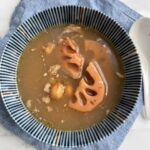
Chinese Lotus Root Pork Bone Soup
Equipment
- 1 stovetop pressure cooker
Ingredients
For parboiling pork bones
- 1.5 lbs pork neck bones
- 2 quarts water
For Broth
- 3 lotus roots peeled, trimmed, and sliced into 1/4 inch thick pieces
- 1 quart chicken broth
- 3 quarts water
- 1/3 cup fish sauce
- 1 tsp salt
- 1 handful dried jujubes
- 2 inch piece of ginger smashed
- 1 tbsp sugar
For Boiled Peanuts
- 1 cup raw peanuts
- 1 quart water
Instructions
- Take a large stockpot and fill it with 2 quarts water. Place on high heat to boil When water has boiled, add in pork bones and parboil for 5 minutes to allow impurities to cook out into the water.
- Then pour out the liquid from the pot and run the bones through running water. Using your hands, scrub off and rinse off all impurities. Set clean pork bones aside.
- Add pork bones back into the pot. Fill the pot with 1 quart chicken broth, jujubes, ginger, 3 quarts water, salt, and sugar. Turn on stove to high and bring water to a boil. Once the mixture is at a boil, allow to simmer for 2 hours.
- While pork broth is simmering, place raw peanuts into a pressure cooker and fill with 1 quart of water. Close the lid and heat the pot on high until the pot begins to whistle. When it begins to whistle, turn the heat to the lowest setting and allow to simmer for about 45 minutes. After 45 minutes, place the pressure cooker under the kitchen faucet and rinse with cold water until the lid has de-pressurized. Then open the lid.
- Strain the liquid and remove cooked peanuts. Add peanuts into the pork bone broth.
- Prep lotus roots. First peel the skin off of them. Then cut off the end pieces. The roots have dark end pieces with rough fibers. Using your knife, peel these ends off as well as any dark parts of the lotus root. Cut the lotus root into 1/4 inch slices. Then add in lotus root pieces to the pork bone broth and allow to simmer with peanuts for at least 1.5 hours.
- When the lotus root is just tender, add fish sauce to taste.
What Goes Into Hotpot?
- Flavorful Broth
- An assortment of vegetables: napa cabbage, bok choy, yu choy
- An assortment of proteins: thinly sliced meats, quick cooking seafood
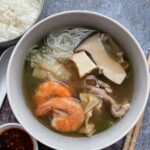
Easy Miso Hotpot
Ingredients
- 2 quarts low sodium chicken broth
- 2 tbsp miso paste
- 2 tsp instant dashi
- 1 quart water
- 1 head Napa cabbage chopped into 1 inch pieces
- 1 bunch enoki mushroom washed, ends cut off, and separated into small sections
- 3 trumpet mushrooms washed and thinly sliced
- 1 package firm tofu cut into 1-inch cubes
- 1 lb shrimp
- 2 lbs thinly sliced beef
- 1 bunch mung bean glass noodles
Dipping Sauce
- 1/2 cup soy sauce
- 1/4 cup chili crisp
- 1 tbsp sugar
- 1 tsp white vinegar
Instructions
- Using a whisk, whisk in miso paste into 1/2 cup of hot water. When the miso paste is well dissolved, add into a large pot. Add in the chicken broth, instant dashi, and the rest of the water. Bring the pot of soup to a boil. Taste for seasoning and add salt, instant dashi, or fish sauce, or miso paste as needed.
- When the broth comes to a boil, add in all of the napa cabbage. Simmer on medium for another 5 minutes. After the cabbage softens, add in trumpet mushrooms and enoki mushrooms. Allow to cook on medium heat another 5 minutes until mushrooms are cooked through.
- Then add in shrimp, tofu cubes, and glass noodles and simmer for another 5 minutes on medium heat.
- Lastly add in the thinly sliced beef and allow to cook through for another 30 seconds. Serve immediately.
- Mix together dipping sauce: soy sauce, chili crisp, sugar, and vinegar. Dip each hotpot item into the dipping sauce and enjoy.
I have to thank Emeril Lagasse for inspiring this recipe. He is my childhood celebrity chef hero and I finally got to eat at his restaurants in 2012 and in 2019. His restaurant served a version of shrimp bisque that changed my world. I loved how he incorporated little crunchy bits of goodies in his shrimp bisque. Kept things interesting with different textures to contrast the creaminess.
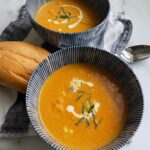
Creamy Shrimp and Corn Bisque
Ingredients
- 1 quart water
- shells of 2 lbs of shrimp
- 1 tbsp oil
- 1/2 onion finely chopped
- 2 stalks celery finely chopped
- 2 carrots peeled and finely chopped
- 1 clove garlic
- 1 tbsp tomato paste
- 1/4 cup white wine
- 1 tbsp Penzey's seafood base
- 1 quart low sodium chicken broth
- 1/2 tsp Old Bay seasoning
- 1/2 tsp Lawry's seasoned salt
- 1 pinch saffron
- 1/2 cup heavy cream
- 2 ears corn corn kernels cut
- 1 stalk celery finely chopped; reserve for later
- 1 lb shrimp rough chopped
Instructions
- Peel shrimp. Save shrimp shells for the shrimp broth. Put away 1 lb of shrimp for later use and set aside 1 lb of shrimp for the bisque.
- Heat 1 quart of water until boiling. Add in shrimp shells. Boil on medium high for 30 minutes.
- Place a large stockpot on high heat. Add in oil. Add in onion, the 2 stalks of finely chopped celery, and carrots and saute 5 minutes. Add in garlic and tomato paste. Saute 1 more minute.
- Then add in white wine and seafood base. Mix well for 1 minute. Then add chicken broth and seafood base. Add in shrimp stock, chicken stock, Old Bay seasoning, Lawry's seasoned salt, and saffron. Simmer for 20 minutes until vegetables are completely softened.
- Blend the soup in a blender until completely smooth. Then add in heavy whipping cream. Place in corn and simmer for 8 minutes. Then add shrimp and cook for 5 minutes until just cooked through. Add the 1 stalk of finely chopped celery. Adjust for seasoning and serve immediately.
For other comforting soup recipes check out my curry butternut squash soup.
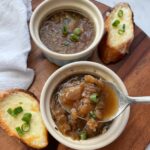
Deconstructed French Onion Soup
Ingredients
- 1 tbsp butter
- 2 tbsp oil
- 4 large sweet onions thinly sliced
- 1/2 tsp dried thyme
- 3 cloves garlic
- 1 tsp salt
- 1 tsp sugar
- 1 tsp beef base
- 1/2 cup dry sherry
- 1 quart low sodium chicken stock
- 1/2 cup Gruyere shredded
- 4 slices baguette
Instructions
- Add butter, oil, onions, thyme, garlic, and salt into a large pot. Saute onions in butter and oil with lid on for 10 minutes. High heat. Stir occasionally. Cook until softened.
- Then take off lid, add sugar, and continue to cook on high for another 15-20 minutes. Cook onions until they become a medium brown color.
- When onions are brown, add in sherry. Then add in stock, beef base, and stir gently, rubbing off the flavorful bits from the surfaces of the pan. Simmer another 20 minutes.
- Preheat oven to 350 degrees. Place sliced baguettes onto a sheet tray and place inside oven. After toasting 5 minutes, flip and top with cheese. Set oven to low broil and place toast into oven for another 3 minutes until cheese is melted and slightly brown.
- Serve soup with cheese toast.
But rather than spending $10 on a quart of store-bought bone broth, I highly encourage you to make it on your own. You got much more bang for your buck. It tastes much richer and has better nutritional value. Plus, you got the nibble on the bits of slow-cooked meat-yum!
How to Make Bone Broth
- Bring a large pot of water to boil. When water is boiled. Add in pork neck bones. Allow to boil for 5 minutes until a brown foam forms on top. Then throw out the water and rinse out the bones until they are clean.
- Another technique is used in Korean cooking for making a clean bone broth: soak the bones in water overnight, then discard the water. This should remove most of the excess blood in the meat.
- Boil 4 quarts of water for broth. When the water is boiled. Add in cleaned pork neck bones. Add in aromatics and seasoning. Allow to simmer on medium for 1-3 hours for the best flavor.
For other recipes featuring bone broth, check out my Chinese Pork Wonton Soup Recipe.
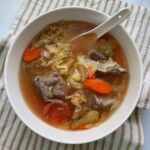
Chinese Pork Bone Soup with Vegetables
Ingredients
- 2 lb pork bones
- 1 gallon water
- 3 carrots peeled and roughly chopped
- 2 tomatoes cut into wedges
- 2 cups Napa cabbage cut into 2-inch thick pieces
- 1 tsp salt
- 1 tbsp fish sauce
Instructions
Parboiling Pork Bones
- Bring a large stockpot of water to boil on high heat. When water is boiling, place all pork bones into the water. Allow to boil on high heat for 5-8 minutes, or until no more blood/impurities appear in the water.
- Discard the water from the bones. Wash the bones of any foam or impurities.
Making the Broth
- Place pork bones and 1 gallon water into a large pot. Bring this pot to a boil on high heat, then reduce heat to medium for a simmer. Add in carrots and salt. Allow to simmer on low heat for about 1.5 hours.
- Then add Napa cabbage and tomatoes. Simmer another 15 minutes until both are softened.
- Add fish sauce. Add additional fish sauce and salt to taste.
- Serve hot. The meat from pork bones can also be eaten, usually with a dipping sauce like nuoc mam or soy sauce.
How to make a delicious Hong Kong Beef Stew
- Use good quality beef that becomes tender when cooked for a long time (short rib, chuck roast)
- Sear the beef before cooking
- Take time to cook out tomato past and aromatics before adding broth
- Use a high quality beef broth
- Add some beef stock base for extra umami
- Make sure to season every step of cooking. Season your meat before searing and then season the soup itself as it is cooking. The salt and spices will absorb into the meat and vegetables as they cook.
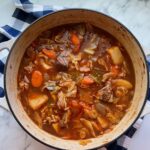
Hong Kong Beef Stew
Ingredients
- 1 tsp salt
- 1.5 lb beef stew meat
- 2 carrots roughly chopped
- 2 stalks celery roughly chopped
- 1 tbsp canola oil
- 1/2 onion diced
- 1 bay leaf
- 3 tomatoes roughly chopped
- 1 1/2 tbsp tomato paste
- 1 tbsp ketchup
- 1 quart beef broth
- 1 1/2 quarts water
- 1/2 head small cabbage roughly chopped
- 3 tsp seasoned salt
- 1 tbsp sugar
- 2 white potatoes cut into 2-inch cubes
Instructions
- Season beef with salt and mix well into meat. Then heat a large pot on high heat. Add in meat to brown. Sear about 3-5 minutes each side.
- Remove meat from pan. Then add in carrots, celery, onion, tomato paste, and ketchup. Saute for 5 minutes.
- Add in beef broth, water, bay leaf, seasoned salt, and sugar. Bring to a boil. Then turn heat to low and allow to simmer for 1.5-2 hours until meat is tender.
- Occasionally remove foam that builds up on the surface of the stew.
- When meat is tender, add in potatoes and turn up heat to medium. Allow to cook until potatoes are tender, approximately 20 minutes.
- Taste for seasoning and add salt or sugar to taste.
For other beef stew recipes, check out my French Beef Burgundy Stew and American style Classic Beef Vegetable Stew.
The post Hong Kong Beef Stew appeared first on Jenn's Kitchen Diary.]]>On cold days, there is nothing you crave more than a huge bowl of piping hot, steamy, soup. Especially pork wonton soup. And even better if it’s homemade.
The Asian in me really comes out during the fall and winter months because I am eating pho at least once a week.
Beside pho, you can try other Vietnamese noodle soups:
Bun bo hue- a spicy lemon-grass flavored beef and pork noodle soup
Bun rieu- noodle soup in a garlicky tomato and crab + pork meatball infused broth
Chinese chicken noodle soup- big chunks of chicken with rice noodle, fresh gingery broth, with cilantro and green onion.
If you just drooled a bit, then you are on the right track. These are delicious Vietnamese noodle soups that will add significantly to your noodle soup game!
Speaking of delicious noodle soup, homemade pork wontons soup is something that is a labor of love, but is so comforting and delicious. It will be worth every painstaking effort that you take to wrap these delicious dumplings.
For other winter comfort foods, check out:
French Beef Burgundy Stew
Albondigas Soup
Chinese Sticky Rice with Preserved Meats
Making Pork Wonton Soup in Bulk
Whenever I make dumplings or wontons of any kind, I make them in bulk. They are quite the undertaking and require lots of elbow grease….well, finger grease is more like it. Fine motor skills are very important in wonton wrapping and you might find your palm cramping after an hour or two of wrapping.
What if I am bad at wrapping?
I laugh every time I think of myself wrapping anything-dumplings, spring rolls, wontons. I was notoriously bad at wrapping anything in my family.
You see, I am not exactly known for being graceful or precise with my motor skills. So I’ll often bump into furniture, stub my toes…yes, I am a very dangerous person to have in the kitchen.
But I couldn’t stay away from the kitchen. No matter how many burns I would get on my hands; no matter how many times I accidentally nicked my fingers, I would come right back to the kitchen. With time, I have become more skilled at wrapping wontons. Although my husband Ray will tell you that I often scare him with my moves in the kitchen.
With that, have some faith in yourself. When you’ve practiced enough, you will get better and better! Please see tutorial below for step-by-step instructions.
How to fold pork wontons
1. Take a wonton wrapper and place it with a corner pointing down toward you (it will look like there is a kite on your plate). Place ~1 tbsp of filling onto the top half of the wonton. Take the eggwash with your finger and spread it along the top edges of your wonton wrapper.
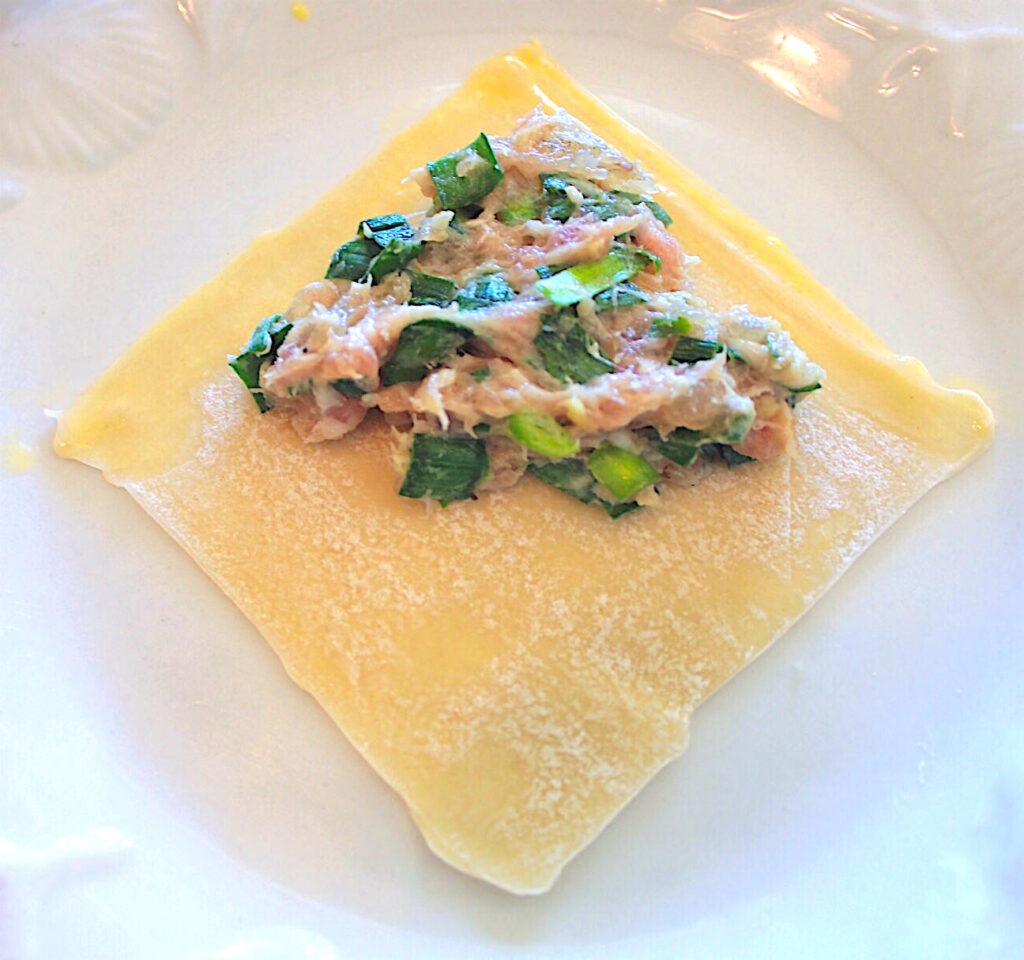
2. Then fold the bottom half up and over the top half, pushing out any excess air. Use your fingers to press down firmly on the edges to create a tight seal. You should end up with a triangle with the base on the bottom.
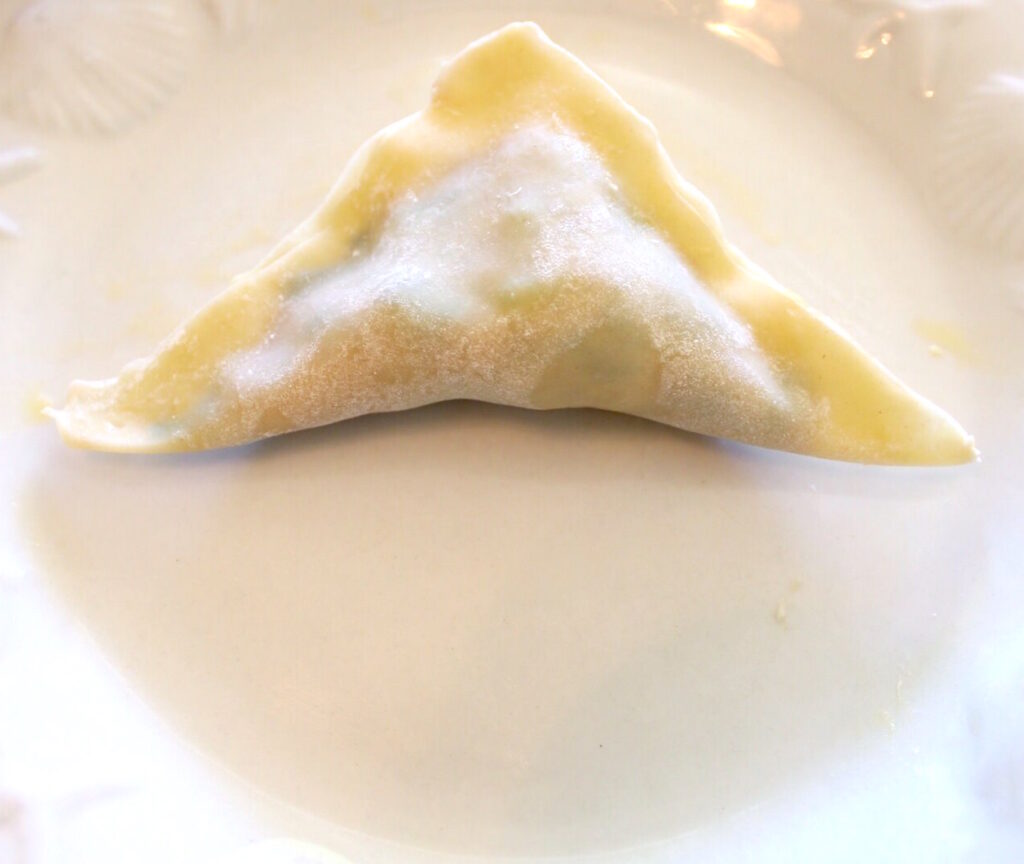
3. Take the two corners on the left and right, and fold one over the other until they slightly overlap. Press down firmly to create a strong seal. Repeat.
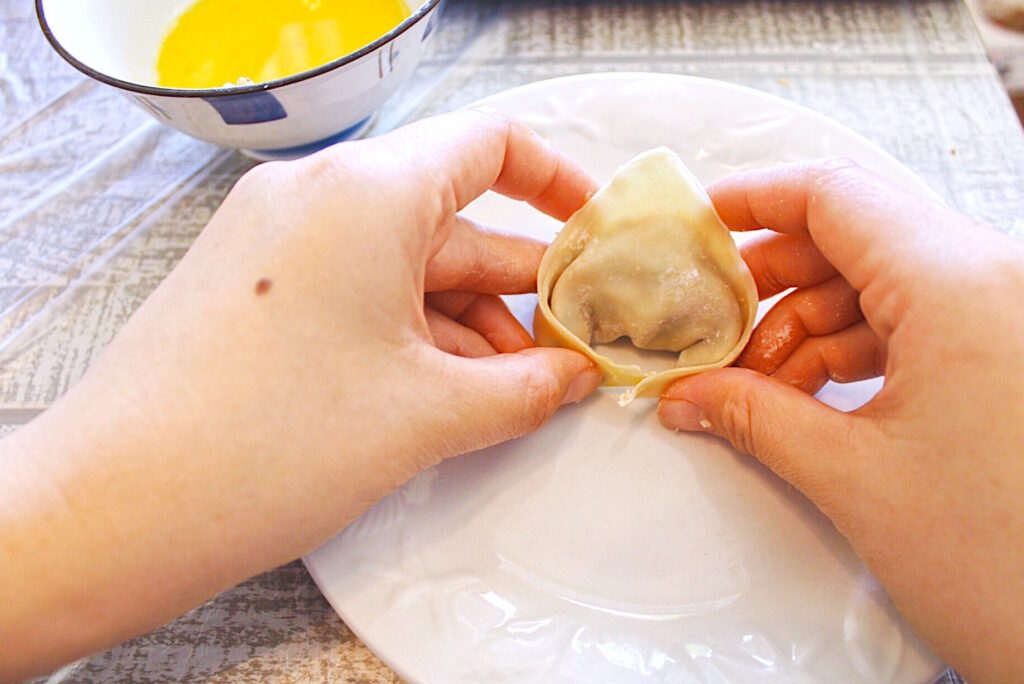
4. Repeat and you will get a beautiful plate of wrapped pork wontons. Tada!
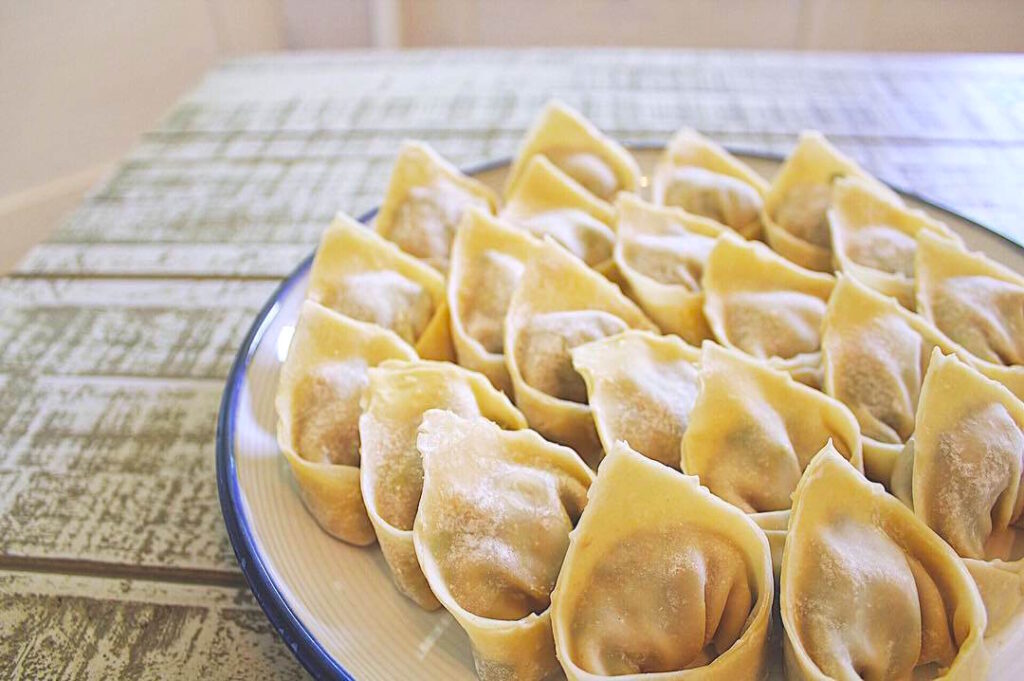
How do I eat pork wontons?
There are many ways to eat wontons. Most people boil them and serve them with either a sauce or flavorful bone broth soup. Sometimes people deep fry them, but that is not traditional.
How do I make flavorful soup?
I feel like Asians were the OG bone broth lovers way before it became cool. Asian broths are not to be taken lightly. They are simmered for hours on end to extract every ounce of flavor from the ingredients you place into the pot. Lots of aromatics, bones, and meats go into the soup to give it tons of flavor. The soup that I made for this recipe was flavored with dried shrimp, which packs a strong umami salty bite, and pork neck bones.
Dried shrimp is a very common Cantonese ingredient and is treated like an aromatic similar to garlic. It adds a nice rich funkiness to the broth. But I realize that dried shrimp is not everyone’s cup of tea. So feel free to omit.
Common ingredients are:
- ginger
- garlic
- rice wine
- some kind of meat
- some kind of bone
- salt
- fish sauce or salt
Can I use pre-made wonton wrappers for pork wontons?
Yes! Yes! Yes! Buying pre-made wonton wrappers is a huge time saver. I have never made my own wonton skins. The fun part is that you can use them as a quick ravioli wrapper as well if you are short on time.
How do I make Chinese pork wonton filling?
In any Chinese meatball dish, picking up the ball of meat and slamming it back into the bowl is essential in creating the perfect texture. This and the addition of a glutinous component-usually corn starch. Chinese meatballs are springy and bouncy. They do not fall apart or melt in your mouth like Italian style meatballs. So make sure you give your meat mixture a few good slams into the bowl before you start filling your wontons.
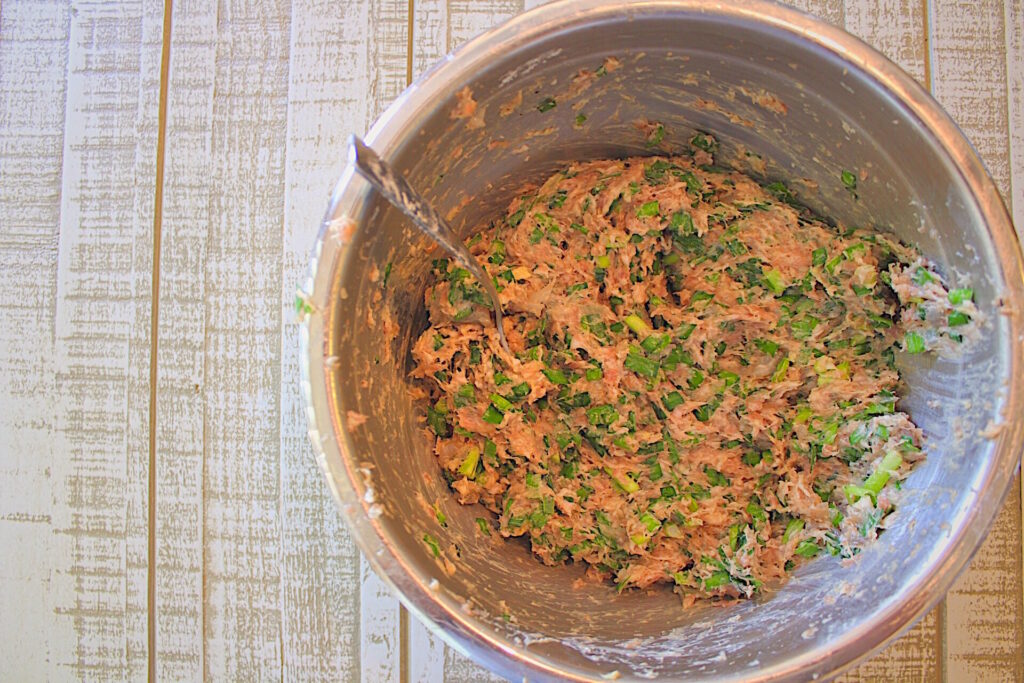
Pro tip: Always cook and taste part of your meat mixture to check for spices and seasoning before stuffing it into the wonton wrappers. You do not want to spend hours on a large serving of food, only to discover it was under or over seasoned.
What a total bummer. Prevention is key, folks!
Do the same for your burgers, meatball mixtures, meatloaf, ravioli fillings and whatever marinated mixture you make.
Making Shallot Oil
This last one is more of a tip of life. Make shallot oil. Lots of it! It will add a burst of flavor to all of your Asian dishes. Many Vietnamese, Cambodian, Chinese, and Thai dishes have this as a garnish, but it is so much more than that. It packs so much caramelized rich flavor that it acts more as a spice or seasoning. Do it. You’re welcome. 
Price Comparison
When you buy a bowl of pork wontons soup, it usually costs between $8-12 depending on the restaurant you are at. While you may not save much money in making these yourself, they will almost always taste better when you make homemade pork wontons. Why? Restaurants tend to put less of the good stuff-shrimp, pork, and filling overall. Asian restaurants also tend to put too much MSG in their pork wontons soup rather than pulling out the flavor stops that we do in this recipe.
Without further ado, here is the recipe.
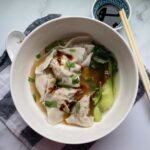
Pork Wontons Soup
Ingredients
Wontons
- 2 lb ground pork
- 1 lb raw shrimp rough chopped or roughly ground
- 1 head garlic minced
- 2 inch piece of ginger minced
- 1 bunch green onion or garlic chives cut into ½ inch pieces
- 1 tsp salt
- 1 tbsp black pepper
- 2 tbsp soy sauce
- 2 tbsp oyster sauce
- 1 tbsp sesame oil
- 1 tbsp xiaoxing or rice wine
- 1 tbsp sugar
- 2 packages wonton wrappers
- 1 egg beaten
- 3 tbsp water
Pork Broth
- 2 lb pork neck bones
- 1 handful dried shrimp
- 2 tbsp fish sauce or to taste
- 4 quarts water
- 3 cloves garlic
- 1 tsp salt
Toppings
- 1 bunch bok choy boiled
- 1 bunch green onion chopped
- 1 handful cilantro chopped
Shallot Oil
- 2 shallots chopped
- 1/2 cup oil
Instructions
Pork Broth
- Bring a large pot of water to boil. When water is boiled. Add in pork neck bones. Allow to boil for 5 minutes until a brown foam forms on top. Then throw out the water and rinse out the bones until they are clean.
- Boil 4 quarts of water for broth. When the water is boiled. Add in cleaned pork neck bones. Add in dried shrimp, garlic, fish sauce, and whole garlic cloves. Allow to simmer on medium for 1-2 hours.
Wontons
- Prepare meat mixture by adding in pork, shrimp, garlic, ginger, garlic chives, salt, pepper, soy sauce, oyster sauce, sesame oil, rice wine, and sugar. Place ground beef, spices, soy sauce, rice wine, and sugar into a large mixing bowl. Use hands to mix together all ingredients.
- Pick up a handful of the meat mixture, lift slightly above the bowl, and then throw it back into the bowl with force. Repeat at least 5 times. Set meat mixture aside.
- Prepare eggwash for wonton wrapping by adding a beaten egg to water in a bowl. Beat well.
- Fold dumplings according to instructions above.
- Boil another pot of water. When water is boiling, add in wontons and allow to boil ~7-10 minutes. Remove wontons from water when they begin to float to the top. Set aside.
- After wontons are cooked, place bok choy in the water to boil for 2-3 minutes until slightly softened. Set aside.
Shallot Oil
- Heat a pot of oil until it begins to slightly smoke. Then turn fire on medium.
- Add in shallots to fry. Stir occasionally until shallots become golden brown.
Assembly
- Place boiled wontons into a bowl. Ladle in boiled pork broth. Top with boiled bok choy, cilantro, green onion, and shallot oil.
Happy cooking! Tag me on Instagram @jennskitchendiary if you’ve made this dish! Would love to see how it turned out.
The post Classic Chinese Pork Wonton Soup-The Ultimate Comfort Food appeared first on Jenn's Kitchen Diary.]]>What kind of protein do I need for kimchi stew?
Use whatever you have lying around. Popular proteins for kimchi stew include tuna, shellfish, and even pork belly.
What do I serve with spicy beef kimchi stew?
A full Korean meal set includes a stew, rice, and a bunch of side dishes called banchan. These side dishes usually are comprised of various pickled vegetables, marinated eggs, dried seafood. You can find a link to some of these banchan recipes in my Easy Korean Barbecue at Home post.
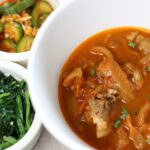
Spicy Beef Kimchi Stew
Ingredients
- 1 tbsp sesame oil
- 1/2 cup kimchi finely chopped
- 2 cloves garlic minced
- 2 oz thin beef slices roughly chopped
- 1/2 quart beef broth
- 1/2 cup cabbage thinly sliced
- 1/2 tsp fish sauce
- 2 tsp hot pepper flakes
- 1 tsp sugar
- 1 tsp gochujang
Instructions
- Heat a large saucepan on high heat. Add in sesame oil when pan is hot. Then add in kimchi and garlic. Fry for 3 minutes.
- Then add in beef, beef broth, cabbage, fish sauce, hot pepper flake, sugar, and gochujang.
- Simmer for 15 minutes. Then taste for seasoning and add fish sauce and red pepper flake to taste. Serve with freshly steamed jasmine rice.